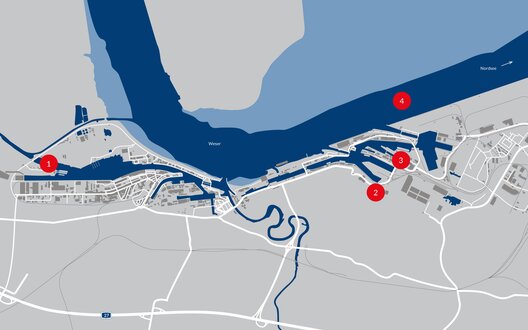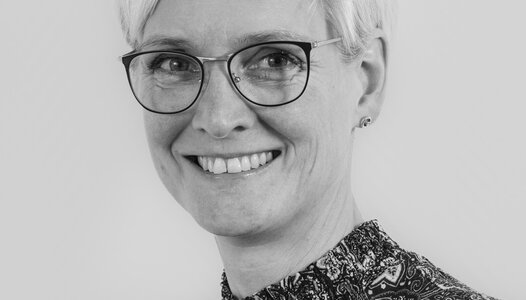Since the early 2000s, offshore wind energy has been one of Bremerhaven’s key topics that is constantly evolving. It is not only a central component of the energy transition and global climate protection but also one of the city’s main flagships.
Today, Bremerhaven is internationally recognized as competence center for offshore wind energy. Its leading position is based on consistent cooperation and the city’s joint strategy: research facilities such as the Fraunhofer IWES and the fk-wind institute as well as the wind tunnel center of Deutsche WindGuard drive innovation.
In additon, the Bremerhaven University of Applied Sciences trains skilled workers. Together with the maritime expertise of numerous suppliers and service providers, the logistically favorable location on the deep water and the unique cluster of locations in northwest Germany, they form an ideal basis for the city‘s success story.
In Bremerhaven and its surrounding area, numerous companies form an entire value chain for onshore and offshore wind energy. From suppliers for the construction of wind turbines and engineering firms to developers and operators of wind farms - the diversity of players involved makes Bremerhaven a dynamic center for the industry.
A major advantage for the offshore wind energy industry in Bremerhaven is the close networking with other established sectors of the economy in the state of Bremen. These include in particular the maritime industry and logistics, aerospace and the automotive industry. Their interaction facilitates a fruitful transfer of knowledge and allows proven technologies and cross-industry expertise to be utilized.
Bremerhaven is a center for research and development in the wind energy sector. The Fraunhofer Institute for Wind Energy Systems (IWES) forms the core, working on key topics of wind energy in an industry-oriented manner. This focus is underlined by ist specialized infrastructure, including a rotor blade test center and the Dynamic Nacelle Testing Laboratory (DyNaLab).
The IWES in Bremerhaven focuses on the testing of nacelles and the investigation of electrical properties. It qualifies for certification of composite materials and components, operates applications for wind energy field measurements (AWF) and carries out site assessments for wind turbines. These efforts are complemented by the Deutsche WindGuard Engineering GmbH, which operates a unique, acoustically optimized wind tunnel for wind power research. Furthermore, the Institute for Wind Energy at the Bremerhaven University of Applied Sciences is intensively comitted to applyingresearch of wind energy technology to commercial practice. Together, they for a rich ecosystem of innovation which is complemented by specialized engineering firms and planners deeply involved in the diverse field of offshore wind energy.
Fraunhofer IWES Bremerhaven and Bremerhaven University of Applied Sciences work closely together to promote research and development as well as the training of specialists. The Bachelor's degree courses in Sustainable Energy and Environmental Technologies, Engineering and Transportation/Logistics as well as the Master's degree courses in Wind Energy Technology, Process Engineering and Energy Technology and Logistics Engineering and Management are of interest to industry-related experts.
The internationally active company RelyOnNutec in Bremerhaven also contributes to training in various areas. In addition, educational institutions in Bremerhaven offer qualifications and further training for professionally relevant positions in the industry.

Bremerhaven as a location for the energy transition represents a great opportunity for German climate policy. The ambitious climate targets and the reduction of import dependency on fossil fuels can only be achieved with the help oft he ports. Functioning ports are a key prerequisite for the construction and operation of additional offshore wind farms and play an important role in the development of value chains for new energy sources such as hydrogen.
The state government will give high priority to pressing ahead with the plans for an Energy Port in Bremerhaven that have been approved by the Senate. In order to speed up the planning and approval process, the Bremerhaven Economic Development Company (BIS) takes on the initiative at federal level to ensure that the construction of the port infrastructure required to implement the energy transition is enshrined as a priority in theRenewable Energy Souces Act.
The offshore wind energy industry needs space close to the deep sea for the production, storage, supply, logistics, service and maintenance of offshore wind farms. In the southern part of Bremerhaven, in the immediate vicinity of the IWES and the planned Energy Port, the first areas are already available for new settlements. The conversion of 100 hectares of the former airfield site and adjacent areas on the Luneplate create ideal conditions for companies from the wind energy and green economy sectors.
This location offers quick access to the A 27 highway. Wind turbines and other large industrial components can be shipped via the heavy load area in the Labradorhafen, the southern area of the Eurogate container terminal and the offshore terminal ABC-Halbinsel (BLG). To put it in a nutshell, Bremerhaven's industrial and commercial areas are well positioned to support the logistical requirements of the offshore wind energy sector.

Dr. Saskia Greiner